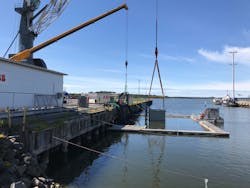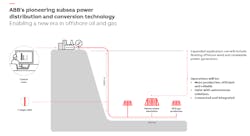ABB validates subsea power system
Offshore staff
ZURICH, Switzerland – ABB has completed a 3,000-hour shallow-water test of its subsea power distribution and conversion technology system.
According to the company, for the first time worldwide, energy companies will be able to access a reliable supply of up to 100 megawatts of power, over distances up to 600 km (373 mi), and water depths up to 3,000 m (9,842 ft). This is all achievable with a single cable with little or no maintenance for up to 30 years.
The $100-million research, design, and development joint industry project between ABB, Equinor, Total, and Chevron began in 2013. The validation of the shallow-water test at a sheltered harbor in Vaasa, Finland, means the majority of the world’s offshore hydrocarbon resources are now in reach for electrification, the company said.
Dr. Peter Terwiesch, President of ABB’s Industrial Automation business, said: “This milestone marks an outstanding achievement and is the culmination point of an inspirational technology development achieved through tremendous dedication, expertise and perseverance. It is the result of intensive collaboration by over 200 scientists and engineers from ABB, Equinor, Total, and Chevron in a multi-year, joint effort.”
By powering pumps and compressors on the seabed, closer to the reservoir, ABB’s subsea power distribution and conversion technology can reduce power consumption. There is potential for substantial energy savings, with reduced carbon emissions using power from shore, the company said. Its subsea power technology can connect to any power source, enabling future integrations with renewable energy, such as wind and hydro power.
Based on a specific field development case, the new technology could offer capex savings of more than $500 million, if eight consumers, such as pumps or compressors, are linked through a single cable over a distance of 200 km (124 mi) from other infrastructure.
“Moving the entire oil and gas production facility to the seabed is no longer a dream. Remotely operated, increasingly autonomous, subsea facilities powered by lower carbon energy are more likely to become a reality as we transition towards a new energy future,” said Dr. Terwiesch.
Previously, only the transmission cable and subsea step-down transformer were proven to operate underwater. Today, the company’s complete subsea power distribution and conversion system includes a step-down transformer, medium voltage variable speed drives and switchgear, control and low voltage power distribution, and power electronics and control systems. Its flagship distributed control system, ABB Ability System 800xA, controlled the testing.
11/20/2019

